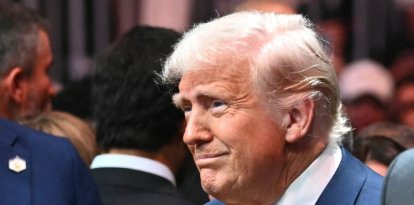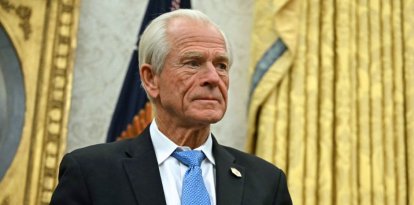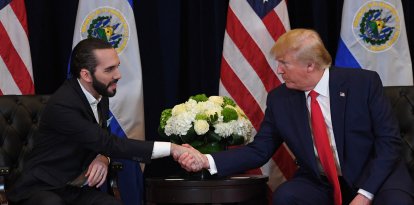Trump's war on fentanyl: The details of his fight to save the US
As fentanyl kills thousands, the Trump administration launches an all-out, unprecedented offensive to combat it.
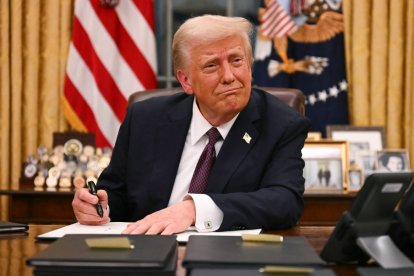
US President Donald Trump.
In the shadows of the border, a lethal alliance weaves its web: fentanyl, a white powder deadlier than any weapon, crosses oceans and deserts to sow chaos in the United States, putting tens of thousands of lives under its relentless yoke.
As Mexican cartels and Chinese brokers turn this drug into a multibillion-dollar business that defies authorities and destroys communities, a powerful force has emerged to confront it. Since taking office on January 20, 2025, Donald Trump's administration has launched a relentless crusade against this epidemic that threatens to turn cities into graveyards.
In less than two months, the Republican has deployed an unprecedented strategy, an unstoppable battering ram that seeks to break the chains of this machinery of death.
Before assuming the presidency, Trump had set his sights on this crisis. In a call with Xi Jinping, president of China, he sought to address the fentanyl problem together, yearning for a more peaceful and secure world, as he shared on Truth Social:
"I just spoke to Chairman Xi Jinping of China. We discussed balancing Trade, Fentanyl, TikTok, and many other subjects. President Xi and I will do everything possible to make the World more peaceful and safe!"
It was the first step in the right direction from a leader determined to act.
In less than two months, he has deployed an unprecedented strategy: tariffs shaking economies, CIA MQ-9 Reaper drones flying over Mexico in search of clandestine labs, 10,000 Mexican troops mobilized under diplomatic pressure, and special forces training the Mexican Navy. Trump's administration is a relentless crusade, a titanic effort to break the chains of this deadly alliance between cartels and Chinese brokers.
Moreover, he has declared the cartels as foreign terrorist organizations "because of the major threat of illegal aliens and deadly drugs killing our Citizens, including fentanyl."
Mexico and China's responses: A dance of avoidance
As the Trump administration lashes out at this deadly alliance, Mexico and China stand firm in shifting blame, weaving a dance of evasion that points north and leaves Washington facing the mirror of a tragedy. Claudia Sheinbaum, Mexico's president, issued a direct challenge: "Start with your country," she asked Trump, questioning how fentanyl moves across the border. "Is it going to be solved by fentanyl disappearing if there are consumers? They'll invent another substance just as deadly," he asserted, insisting that the solution lies not just in stopping the supply, but in attacking the demand that flourishes on U.S. soil. She rejected the White House's accusations of having an "intolerable alliance" with the cartels. The Mexican woman called the Republican's statements "irresponsible" and "slanderous", defending Mexico's sovereignty against what she considers an unfair narrative.
However, in the face of Trump's tariffs, Sheinbaum lowered her tone and proposed dialogue: "It is not by imposing tariffs that problems are solved, but by talking," she said, seeking a negotiated solution without giving in to her position.
This attitude differs somewhat from that of Andres Manuel Lopez Obrador, who years ago in 2023 completely denied fentanyl production in Mexico.
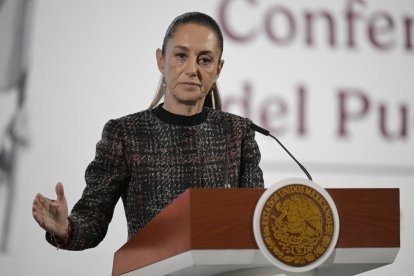
Mexico President Claudia Sheinbaum.
From Beijing, the message echoes: "Fentanyl is a US problem," replied the Chinese Embassy in Mexico, defending that "China is one of the countries with the strictest and most rigorously implemented anti-drug policies in the world." Liu Pengyu of the Ministry of Foreign Affairs added that "China has carried out extensive anti-drug cooperation with the United States and achieved remarkable results," accusing Trump of "disregarding the fruitful cooperation" and using the crisis as "a pretext" to punish them with tariffs.
Both countries point north and wash their hands in a dance of evasion, leaving Washington to face the mirror of a tragedy.
However, the blame game between Mexico and China is not recent. It has been going on for some years now. During the Biden-Harris administration, the same thing happened. Mexico's denial about fentanyl production in its territory, contrasted with the alarming overdose figures in the United States and the deterioration of anti-drug cooperation with China, marked a period of tensions and insufficient responses in the face of a growing crisis.
The relationship with Mexico and China during the Democratic administration
The alliance between Mexico and China has made fentanyl an unprecedented threat to the United States. At present, fentanyl crosses the border like this. The latest data from Customs and Border Protection (CBP) show that, in fiscal year 2024, Southwest border officials seized 21,148 pounds of fentanyl, the vast majority of which was intercepted from people entering through legal ports of entry.
However, efforts to stem this crisis faced significant hurdles in previous years. In Mexico, cooperation with the United States weakened under the Andrés Manuel López Obrador administration and the Democratic Biden-Harris administration in the United States.
In 2023, López Obrador denied that fentanyl was produced in his country: "here we don't produce fentanyl and we don't have fentanyl consumption," a claim that was disproved by DEA evidence. While Joe Biden said the situation was a "tragedy". However, with 107,543 overdose deaths in 2023 nationwide, of which 81,083 involving synthetic opioids such as fentanyl, according to the Center for Disease Control and Prevention (CDC), the response was insufficient in the face of the scale of the problem.
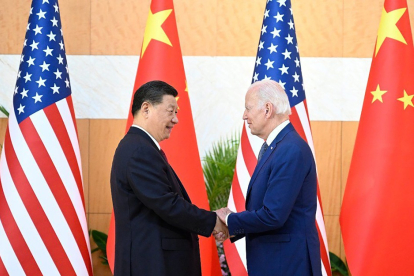
Joe Biden and Xi Jinping.
Between 2021 and 2023, during the Biden-Harris administration, China-U.S. collaboration also significantly deteriorated.. The turning point occurred in August 2022, when China formally suspended anti-drug cooperation with the United States.
This was a direct response to Nancy Pelosi's visit, then speaker of the U.S. House of Representatives, to Taiwan, an event that Beijing interpreted as a provocation and a violation of its sovereignty. Among the retaliatory measures, China cut off several channels of bilateral dialogue, including joint work on narcotics issues.
During this period, the flow of precursor chemicals from China to markets such as Mexico, where they are processed into fentanyl for distribution in the United States continued without the previous controls that bilateral cooperation had facilitated.
The resumption of the dialogue in November 2023 occurred during the Asia-Pacific Economic Cooperation (APEC) summit in San Francisco, where Presidents Joe Biden and Xi Jinping met. At this meeting, both leaders agreed to reestablish anti-drug collaboration, including efforts to curb the export of fentanyl precursors from China.
However, despite operations such as "Last Mile" (2022-2023) conducted by the DEA, which resulted in 3,337 arrests and the seizure of 44 million fentanyl pills, were not enough. Experts such as Arturo Sarukhan, former Mexican ambassador to the United States, warned that, without a change in strategies, the flow will not stop.
The impact and the challenge
The Donald Trump administration, in its second term, faces daunting challenges in this fight against drugs, especially fentanyl. The Republican leader, through his Truth account, recently declared tariffs:
"Drugs are still pouring into our Country from Mexico and Canada at very high and unacceptable levels. A large percentage of these Drugs, much of them in the form of Fentanyl, are made in, and supplied by, China. More than 100,000 people died last year due to the distribution of these dangerous and highly addictive POISONS. Millions of people have died over the last two decades. The families of the victims are devastated and, in many instances, virtually destroyed. We cannot allow this scourge to continue to harm the USA, and therefore, until it stops, or is seriously limited, the proposed TARIFFS scheduled to go into effect on MARCH FOURTH will, indeed, go into effect, as scheduled. China will likewise be charged an additional 10% Tariff on that date. The April Second Reciprocal Tariff date will remain in full force and effect. Thank you for your attention to this matter. GOD BLESS AMERICA!"
Fentanyl has turned states and cities into battlegrounds, leaving behind a trail of death that does not discriminate. In 2024, according to the CDC, more than 87,000 Americans died from overdoses from this drug. In 2023, it was 107,543, with 81,083 linked to synthetic opioids like fentanyl. For its part, CBP seized 21,148 pounds at the southwest border in FY2024, mostly at legal ports.
Canada is not spared either
While China has been identified as the main supplier of precursor chemicals and Mexico as the epicenter of production and trafficking by cartels, Canada is not spared either. The Trump administration has also blamed the neighboring country and its role in the opioid epidemic.
Trump stated, “We have lost millions of people to fentanyl. It comes primarily from China, but it also goes through Mexico and through Canada.” This stance has been accompanied by concrete measures, such as the imposition of 25% tariffs on products coming from Canada to pressure these countries to strengthen their border controls and combat drug trafficking.
The finger-pointing at Canada is not new in Trump's discourse. During his campaign he has insisted that the country, under Justin Trudeau's leadership, has not done enough to stop the flow of illicit drugs into the United States.
The statistics show the reality. According to data, in the last fiscal year, fentanyl seizures at the Canadian border amounted to 19.5 kilograms. This indicates that, although Canada is not the main entry point, there is detectable trafficking. For its part, Canada faces its own opioid crisis, with thousands of overdose deaths annually, many of them linked to fentanyl produced locally or imported as precursors from China.
The Canadian response to Trump's accusations came on the heels of tariff threats, as did the Mexican response. Prime Minister Justin Trudeau negotiated a deal with Trump in February, postponing the tariffs. Days later, the Canadian government, like the Republican administration, announced the classification of seven drug cartels as terrorists, including Mexican groups.
While these actions reflected an attempt by Canada to demonstrate commitment, they are still not enough for the GOP, given the magnitude of the problem. For this reason, the U.S. president will resume his measure and impose the tariffs on March 4.
The places most affected by the fentanyl crisis in the U.S.
Portland and Oregon: Portland, Oregon's largest city, declared a 90-day emergency on January 30, 2024 to address the fentanyl crisis, led by Governor Tina Kotek. Multnomah County reported a 533% increase between 2018 and 2022 (209 fatalities in 2022). In 2024, it reported 201 suspected fatal overdoses between January and April.
California: has been one of the states most affected by fentanyl, in part because of its proximity to the Mexican border. Records show 3,946 fentanyl deaths in 2020 (of 5,502 total opioid deaths) and boasts seizures: 19,600 pounds of fentanyl in FY2024 (through August).
Ohio: has been an epicenter of the opioid epidemic since the 1990s, but fentanyl has elevated the crisis to new levels. In 2023, there were 4,452 unintentional drug overdose deaths. Cities such as Dayton and Cleveland have seen alarming death rates, with fentanyl frequently mixed with cocaine and methamphetamine, increasing its lethality. The state has responded with naloxone distribution programs and police operations, but the numbers remain grim.
New York: fentanyl has quietly transformed the urban landscape. In 2023, the state reported 3,046 overdose deaths, 80% of which involved fentanyl, according to the New York State Department of Health.
Texas: with its extensive border with Mexico, faces a steady flow of fentanyl. In 2023, state authorities seized enough fentanyl to kill millions of people, according to the Texas Department of Public Safety. Its hot spots are in Houston and El Paso. Governor Greg Abbott has prioritized operations such as "Lone Star" to intercept shipments, but the magnitude of the problem continues to grow.
Florida: has seen a dramatic increase in deaths from fentanyl, with nearly 5,900 deaths from synthetic opioids in 2022. Miami and Tampa are key distribution centers, with fentanyl arriving by both sea and land. The state has implemented stricter laws against traffickers and education campaigns.
Washington: in Washington state, fentanyl has gone from being a secondary threat to the primary cause of overdoses. In 2023, more than 1,067 people died from fentanyl overdoses, which represents a 47% increase over the previous year.

Fentanyl seizure in California
Fentanyl and its operations: The criminal machine
Fentanyl, a synthetic opioid 50 times more potent than heroin, has established itself as the most lethal drug in the United States, a threat born of a symbiotic alliance between Mexican cartels and Chinese players.
Mexico produces, China supplies, and the money comes back clean in a circle perpetuating the tragedy. The Sinaloa Cartel and the Jalisco Cartel - New Generation (CJNG), pillars of production, dominate the synthetic opioid market, according to the DEA in its 2023 report.
From Culiacan, the Sinaloa Cartel operates as a transnational enterprise with specialized divisions, while the CJNG, in Jalisco, combines violence and innovation, according to the DEA in another report.
Why fentanyl? The answer is simple. It's cheap (compared with heroin): a kilogram of precursor costs $200 versus $6,000 for heroin, estimates Bryce Pardo of the Rand Drug Policy Research Center. In 2022, the DEA confiscated 379 million lethal doses, enough to kill the entire U.S. population.
China supplies 97% of the seized precursors, such as ANPP and norfentanyl, shipped from Qingdao and Shanghai to Mexican ports like Manzanillo and Lazaro Cardenas, according to the DEA and the Department of Justice (DOJ). Although in 2019, the Chinese government qualified fentanyl as a controlled substance, Chinese companies export disguised precursors. An example of China's journey into Mexico is the seizure in April 2023 by the Mexican Navy with 320 tons of illicit chemicals in six months, many of them of Chinese origin.
For its part, in 2023, the DOJ accused eight Chinese chemical companies, and Treasury sanctioned 13 individuals and 12 entities, including the "Chinese illegal drug syndicate" of Du Changgen (a Chinese businessman and criminal), which since 2016 has used companies such as Hubei Vast and Hanhong Pharmaceutical to supply the cartels.
The money, "billions and billions" according to the DEA, is laundered through Chinese brokers, the cartels generate cash in the United States and brokers in Los Angeles and San Gabriel pick it up. Chinese buyers, limited to $50.000 annually since 2015, pay in yuan via WeChat Pay (with a low commission of 5%-10%) and the funds return in pesos to Mexico.
The DEA conducted operation "Operation Fortune Runner," which ran from 2022 until 2024. This operation detailed the workings of this money laundering mechanism and dismantled a network in California.
Trump administration: Hope on the horizon
Mexican cartels and Chinese brokers have created a perfect cocktail fueling this crisis, but the Trump administration offers a glimmer of light. In less than two months, it has deployed drones, tariffs, economic sanctions and military troops to confront cartels who are now "foreign terrorist organizations" demanding and punishing China to act.
While Sheinbaum from Mexico and Xi from Beijing evade blame, Trump carries the urgency of a leader who promises and acts. The battle is just beginning, but there is hope for the first time in years thanks to a relentless crusade that seeks to break this chain of death and restore security to a tremendously wounded country.
RECOMMENDATION

